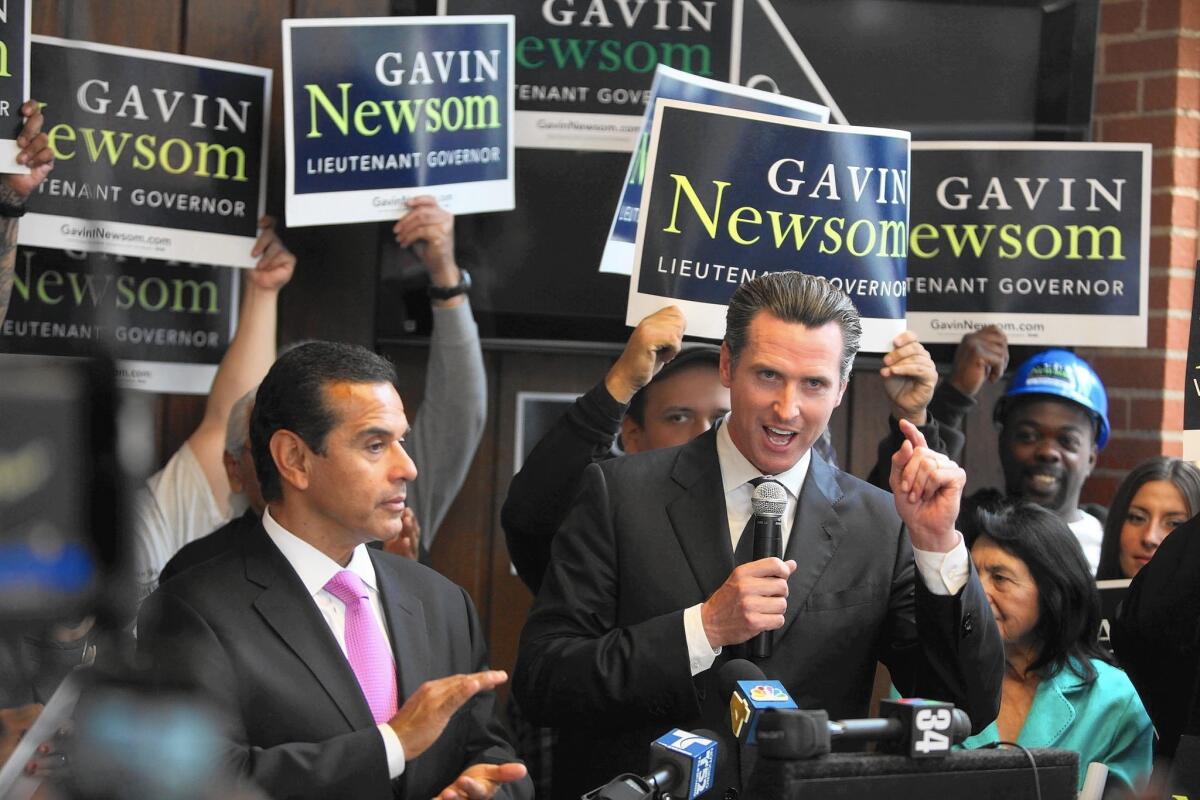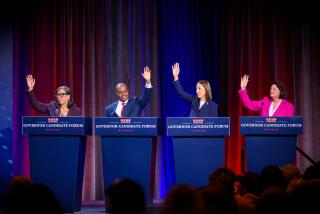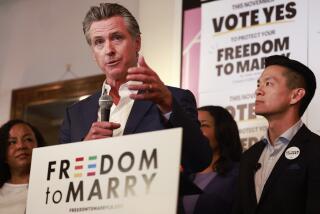Analysis: Newsom, Villaraigosa taking two paths to the same spot on ballot

Gavin Newsom campaigning for lieutenant governor in 2010; then-L.A. Mayor Antonio Villaraigosa is at left. Newsom has declared his bid to succeed Gov. Jerry Brown and Villaraigosa is expected to do likewise.
Two factors are animating the presidential contest among the Democrats who control California’s elections: a sharp left turn and a focus on those who continue to suffer economically. Those topics also are dominating the 2018 campaign for governor.
Yes, Atty. Gen. Kamala Harris and U.S. Rep. Loretta Sanchez, both Democrats, and a host of lesser-known candidates of varied parties are campaigning for the U.S. Senate seat up for grabs one year from now. But Sanchez is visible to Californians mostly through the television cameras aimed at Capitol Hill, and Harris has conducted her campaign with the under-radar stealth of SEAL Team 6.
The result: the most compelling California contest is the one to replace Gov. Jerry Brown, who won his fourth and last term last November.
Lt. Gov. Gavin Newsom, the former mayor of San Francisco, has already announced his candidacy, an early move meant to help him raise money, curate issue positions and, if he has any luck, persuade others to take a pass. Antonio Villaraigosa, the former Assembly speaker and Los Angeles mayor, is an unannounced candidate but, if the views of those close to him count, an inevitable one at this point.
Other potential Democratic entrants are looking at the race — billionaire donor Tom Steyer, former gubernatorial candidate Steve Westly, state Treasurer John Chiang — but it is in Newsom and Villaraigosa’s actions that the sentiments of the state’s dominant voters can be seen.
Newsom’s stock in trade is staking out an early and, often, controversial position, as he did with gay marriage, which he pushed over the objections of other Democrats 11 years before the U.S. Supreme Court would validate his support.
Already, early in the season of preparations for the 2016 ballot, he has announced that he will take on the gun lobby with an initiative to, among other things, outlaw possession of large ammunition magazines and require background checks on any ammunition. He’s also said he will back the legalizing of marijuana for general use, not just for medicinal purposes.
Democrats running for president have likewise indicated their desire to toughen gun rules, after a long period in which most of the party’s politicians were so certain of defeat that they brushed the issue aside. And the left’s favorite candidate this year, Vermont Sen. Bernie Sanders, recently came out for the legalization of marijuana — though Democratic frontrunner Hillary Rodham Clinton has declined to follow suit.
Villaraigosa’s unofficial campaign is almost the polar opposite of Newsom’s. The San Francisco mayor’s gun-and-pot measures will probably be most popular among liberals along California’s coast; Villaraigosa is spending his election run-up treading up and down the state’s more conservative interior.
In recent months, Villaraigosa has spent at least 28 days in the Central Valley and the Inland Empire and other areas still yearning to recover from the recession. He has only occasionally surfaced publicly; most of his meetings have been private stops on what politicians like to call a “listening tour” that lets locals vent and grow comfortable with the visitor.
Back when statewide races were competitive, Villaraigosa’s path was most often trod by Republican candidates, who would travel down the interior valleys and into Orange and San Diego counties. But the state has changed: Inland California is still less liberal than the coast, but more Latino than it was, and, if Villaraigosa’s bet pays off, more likely to embrace a candidate concerned about the area’s continuing economic woes.
At a recent panel sponsored by UCLA’s Blueprint magazine, he essentially outlined his approach.
“People are worried that they are working hard and not making it,” he said at the panel, on the topic of economic inequality. He called it a violation of the American compact that hard work would allow one’s children to “have a better life.”
He scorned those who suggested things are getting better everywhere. “When politicians talk about the California rebound, they are not talking about the Central Valley; they are not talking about San Bernardino,” he said.
Both men assert that they are driven by core beliefs. But their moves have political utility as well.
Newsom, by placing himself again on the front lines, reinforces his positioning as the guy who’s firm in his views, like it or not. He also aligns himself with activists and donors. (And, because he is not on the same ballot as his initiatives, he avoids the direct ire of voters drawn by their opposition.)
Villaraigosa, with his quiet and unofficial campaign, is buying himself a chance to attract those who typically look askance at Los Angeles politicians. His focus on economic recovery undergirds his emphatic push for changing the state’s schools system to aid students for whom education offers rare hope. (And, because there are substantial numbers of Republicans and independents in those areas, it positions him as a backup choice if he and Newsom were to make the top-two runoff.)
The distinctions between the two are not likely to be so clear-cut forever; overlap is inevitable. Newsom spent major parts of his mayorship working on issues like homelessness and healthcare; Villaraigosa was an early supporter of gay rights, children’s healthcare and gun control legislation. Already, they have their eyes on one another.
In an interview Friday with The Times editorial board, Newsom said that he, too, was focused on inequality.
“You can go on a listening tour — that’s not a knock — say that ‘I was milking cows in Hanford and heard from local folks and thank you very much’ and tweet it out,” he said. “We all do that.”
Was he referring to a certain unannounced candidate who might run against him for governor?
“Not ‘might’,” he said, laughing. “Is.”
Twitter: @cathleendecker. For more on politics go to www.latimes.com/decker and www.latimes.com/politics.
More to Read
Sign up for Essential California
The most important California stories and recommendations in your inbox every morning.
You may occasionally receive promotional content from the Los Angeles Times.











